In the world of interior design, the concepts of theme and minimalism often stand out as guiding principles that can completely transform a living space. While they may seem simple at first glance, when applied thoughtfully, they can elevate a home into a sanctuary of peace, functionality, and beauty. Whether you’re looking to refresh a room or redesign your entire home, embracing a theme coupled with minimalist principles can create a harmonious environment that balances aesthetics with functionality. This approach goes beyond simply decluttering your space; it encourages intentionality in every element you choose, from furniture and colors to decor and layout. So, how can you improve your home with theme and minimalism? Let’s explore the key strategies and ideas that will help you achieve a stylish and serene home.
The Power of Theme in Home Design
A theme in home decor is not just a random selection of furniture and colors; it’s a consistent thread that ties all elements of a space together. A well-defined theme gives direction to the design, allowing each piece and color to work in harmony with the others. Without a theme, a room can feel incoherent, lacking purpose and flow. With a clear theme, the room feels complete and well-curated.
The first step in integrating a theme into your home decor is identifying the style or mood you want to create. A theme can be as broad as a geographical region or as specific as a particular color palette or cultural influence. For example, you might choose a Scandinavian theme characterized by clean lines, neutral tones, and natural wood finishes, or you could opt for a coastal theme, incorporating soft blues, whites, and light textures to evoke the serenity of the sea.
Once you’ve selected your theme, it’s important to stay consistent with the elements you choose. This doesn’t mean every item needs to match perfectly, but there should be an underlying connection that ties the room together. This could be achieved through consistent color schemes, materials, or design motifs. The goal is to create an atmosphere that feels cohesive and intentional, where every piece serves a purpose in building the overall aesthetic.
Introducing Minimalism to Your Home
Minimalism is often described as the art of doing more with less. It’s about reducing clutter and distractions to allow for clarity, space, and serenity. While the term “minimalism” can sometimes be associated with stark, cold interiors, in practice, it’s about thoughtful restraint and simplicity. It’s about creating spaces that are functional yet beautiful, where each item has a purpose and every design choice contributes to a sense of calm.
The beauty of minimalism is that it’s not about eliminating everything; it’s about selecting quality over quantity. The key is to be selective with your choices, focusing on what truly enhances your space. Minimalism embraces clean lines, neutral colors, and functional furniture that is both practical and aesthetically pleasing.
Here are several ways you can introduce minimalist principles into your home:
-
Declutter and Simplify
The first step toward minimalism is to clear the clutter. Take a hard look at your space and remove any items that don’t serve a purpose or add value to the room. This includes unnecessary furniture, accessories, or decor that may be adding to visual noise. Aim for a clean and open space, where every item has a designated place. -
Focus on Functionality
Minimalism emphasizes the importance of functional furniture and decor. Choose pieces that are not only beautiful but also practical. For example, an elegant sofa with clean lines might also include built-in storage underneath, or a coffee table may double as a workspace or a spot for extra seating. The goal is to invest in items that serve multiple purposes, reducing the need for excess. -
Simplify Your Color Palette
A minimalist home typically uses a restrained color palette, focusing on neutrals such as white, gray, beige, and muted tones. These colors help create a sense of calm and allow other design elements, such as texture and form, to take center stage. While minimalist design doesn’t require an entirely monochrome space, keeping the color scheme subtle and understated can help the room feel balanced and tranquil. -
Embrace Negative Space
In minimalist design, empty space is just as important as the items you place in a room. Negative space—areas where there’s no furniture or decor—creates a sense of openness and peace. Avoid overcrowding your rooms with too much furniture or decoration, and allow the design elements to breathe. Negative space creates a visual break, which can be soothing to the eye and mind. -
Invest in Quality Over Quantity
One of the core tenets of minimalism is the idea of investing in fewer, higher-quality pieces that will last over time. Instead of filling a room with inexpensive, disposable furniture, focus on investing in timeless, well-crafted pieces that will age beautifully. For example, a high-quality leather chair or a handwoven rug can add both luxury and longevity to a space, elevating its design without overwhelming it.
Blending Theme and Minimalism
While theme and minimalism might initially seem like opposing forces—one rooted in richness and narrative, the other in simplicity and restraint—when combined, they can create a harmonious and balanced environment. The trick lies in selecting a theme that complements minimalist principles and applying it with subtlety and intention.
Here’s how to successfully combine theme and minimalism in your home:
-
Choose a Subtle Theme
Rather than opting for a loud, highly detailed theme, choose one that lends itself to minimalist design. For example, a Japanese-inspired theme may incorporate elements such as sliding doors, tatami mats, and low furniture, which all align with minimalist principles. Similarly, a mid-century modern theme is known for its clean lines and functional furniture, making it a perfect fit for minimalism. -
Use Accents to Highlight the Theme
Instead of overwhelming a room with thematic decor, introduce subtle accents that nod to your chosen theme. For instance, if you’ve chosen a Scandinavian theme, you might incorporate minimalist furniture with natural wood finishes, paired with a few carefully selected Scandinavian-inspired artworks or textiles, such as a simple wool throw or a geometric rug. This allows your theme to shine through without cluttering the space. -
Create Focal Points
In minimalist design, focal points are crucial for adding interest and balance. If your theme is based on a particular cultural influence or color palette, use it as a focal point within the room. For example, you might choose a statement piece of art or a sculptural piece of furniture that embodies the theme, allowing the rest of the room to remain clean and uncluttered. This gives the room depth and personality without overwhelming the minimalist aesthetic. -
Keep Accessories to a Minimum
In both theme and minimalism, accessories should be carefully chosen and not overused. A few thoughtfully placed pieces—such as a vase with fresh flowers or a simple sculpture—can bring your theme to life without detracting from the overall minimalist design. Remember, less is often more when it comes to decorative items. -
Embrace Natural Materials
Incorporating natural materials, such as wood, stone, and metal, is a common theme in minimalist design. Whether your theme is inspired by nature, modern design, or a cultural reference, these materials help ground the space and connect the indoors with the natural world. A stone coffee table or a wooden bookshelf can serve as both functional and thematic pieces that elevate the room while maintaining the minimalist aesthetic.
Conclusion
Improving your home with theme and minimalism is about creating a space that feels intentional, balanced, and serene. By choosing a theme that reflects your personality and interests, and pairing it with minimalist principles of simplicity, functionality, and clarity, you can design a home that is both beautiful and practical. The key is not to overcrowd your space with excessive decor or furnishings, but to select pieces that enhance the atmosphere and functionality of the room. Whether you’re aiming for tranquility, elegance, or a modern touch, combining theme and minimalism will allow you to craft a space that feels calm, cohesive, and deeply connected to your sense of style.

